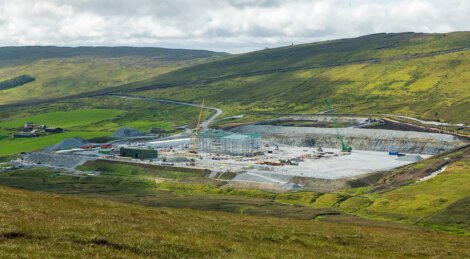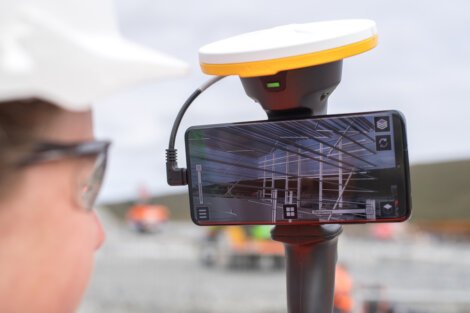Climate / Subsea cable very reliable, says project director
Potential benefits of 5G technology for construction industry to be trialled from next month
THE PROJECT director in charge of building the Kergord converter station and 600MW interconnector infrastructure linking Shetland to the national grid expects the subsea link to be available for 99.8 per cent of the time.
Reacting to concerns voiced locally about the reliability of high voltage direct current (HVDC) subsea cables and the potential consequences of long outages, SSEN Transmission project director John Scott said the company would do everything they could to protect the cable.
“We devote a lot of effort to ensuring that the cable is as much protected as possible, from the initial design, the routing, and the burying and protection of the cable,” he told Shetland News during a visit to the Kergord construction site on Thursday.
He added: “The cable itself is double-wired armoured, so there is physical protection built into that cable to avoid damage from dragging or snagging by fishing gear.
“The cable is then fully buried, so it is fully protected end to end, and on the seabed we achieve that by trenching the cable in about one metre deep.
“Where seabed conditions won’t allow that trenching we will protect the cable with rock to provide a sufficient level of protection.
“In our experience with the Caithness to Moray cable – the most directly relevant one, which we installed in 2018 – we had no issues at all with the cable being damaged or being out of service.”
Lerwick Power Station will remain on standby, should the cable fail, until at least 2035.
“[We have] 99.8 per cent availability of the link; not just the cable, but all the hardware at both ends,” Scott added.
That hardware is currently being built at the site high up in the Kergord valley and along the westside of the valley in preparation for the cable being laid to the landfall site at Weisdale Voe.
Become a member of Shetland News
With the large concrete platform almost complete, rapid progress is being made in erecting the steel works for the main reactor hall – described as the “heart of the site”.
That large building is scheduled to be wind and water tight by December. Due to Shetland’s demanding weather conditions all equipment will be housed inside.
Scott confirmed that the core of the site was constructed with a 40-year lifespan in mind.
Once operational in 2024 to coincide with the expected completion of the Viking Energy wind farm, the converter station will have capacity left for other renewable energy developments, such as the two Peel Energy owned wind farm projects outside Lerwick and in Yell.
But the station could also be the base for delivering electricity elsewhere. Scott confirmed that SSEN transmission has had some early discussions with the Orion clean energy project which hopes to facilitate the decarbonisation of offshore oil and gas installations west of Shetland.
While such discussions are at a very early stage, he said that supplying green electricity north to power oil installations was something the converter station could potentially do.
“They [Orion] are in discussion with ourselves and [SSEN] Distribution around various potential plans around decarbonisation and onshore power connections, but it is at a very early stage in terms of those discussions, and we are effectively waiting on proposals from the oil and gas industry as to what they want or propose,” Scott said.
“There is capacity here [at Kergord], it’s certainly built with a degree of flexibility so that we can either connect sources of electrification or we can supply energy.”
Meanwhile, trials with cutting edge technology will get under way in the remote Kergord valley next month when a 5G private network will be switched on to monitor progress using cameras, drones and mixed reality.
Earlier this year, main contractor BAM Nuttall was granted government money under the 5G Create programme.
The company hopes to learn from the pilot around how best to utilise the new technology in the construction industry to make the planning and the construction of buildings easier.
Apart from rapid data transmission and streaming, the technology could also lead to machinery being operated remotely.
Scott said local company Shetland Flyer was involved in the project.
“At the moment we are using their drones to record footage. It takes a day or so to process and circulate it around the team,” he said.
“With 5G we will have a live stream to the designers in Sweden, or wherever, and engage with them in real time, and resolve things in real time.”
Become a member of Shetland News
Shetland News is asking its many readers to consider paying for membership to get additional features and services: -
- Remove non-local ads;
- Bookmark posts to read later;
- Exclusive curated weekly newsletter;
- Hide membership messages;
- Comments open for discussion.
If you appreciate what we do and feel strongly about impartial local journalism, then please become a member of Shetland News by either making a single payment, or setting up a monthly, quarterly or yearly subscription.
































































